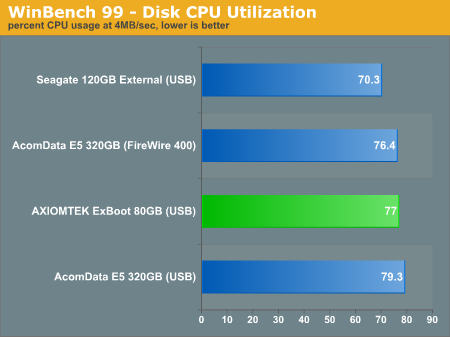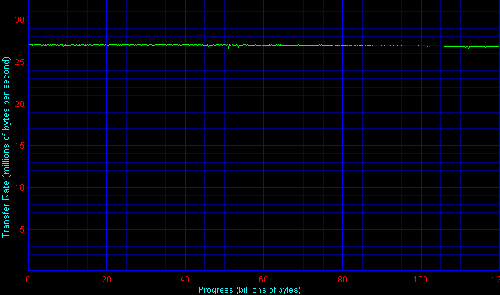Seagate 120GB External Storage
by Purav Sanghani on September 29, 2005 12:05 AM EST- Posted in
- Storage
WinBench 99
We have extended our WinBench 99 portion of our benchmarks to include not only the Disk Transfer Rate tests, but also a handful of other disk performance related tests, including Disk Access Time, CPU Utilization, Disk Playback/Bus, Disk Playback/HE, and Disk Playback/Removable Media. As we present our results, we will explain how each test is relevant in our methodology.
Disk Transfer Rate
In the past, we have just given the beginning and ending transfer rates, which doesn’t really show the performance of the entire disk because there is so much more in between on which we don’t report. Our new method includes a graph:
The transfer rates remained constant at around 27MB/sec, which is about 7MB/sec lower than the E5’s ( AcomData) average transfer rate over the course of the disk. We checked our drivers and made sure that everything in our test bed was the same in testing both the E5 and Seagate’s 120GB unit and are confident of our results.
Disk Access Time
According to WinBench 99, the disk access time on the Seagate is 15ms, which is 1.8ms slower than the Western Digital carrying AcomData. We may be seeing a trend here as the larger 320GB Western Digital based E5 is performing much quicker in the synthetic tests so far.
When testing the AcomData E5, we saw that CPU consumption was about 79.3% while transferring data over the USB interface. The Seagate drive took up less of the CPU’s time as it only consumed an average of 70.3% over its one and only USB interface.
We have extended our WinBench 99 portion of our benchmarks to include not only the Disk Transfer Rate tests, but also a handful of other disk performance related tests, including Disk Access Time, CPU Utilization, Disk Playback/Bus, Disk Playback/HE, and Disk Playback/Removable Media. As we present our results, we will explain how each test is relevant in our methodology.
Disk Transfer Rate
In the past, we have just given the beginning and ending transfer rates, which doesn’t really show the performance of the entire disk because there is so much more in between on which we don’t report. Our new method includes a graph:
The transfer rates remained constant at around 27MB/sec, which is about 7MB/sec lower than the E5’s ( AcomData) average transfer rate over the course of the disk. We checked our drivers and made sure that everything in our test bed was the same in testing both the E5 and Seagate’s 120GB unit and are confident of our results.
Disk Access Time
According to WinBench 99, the disk access time on the Seagate is 15ms, which is 1.8ms slower than the Western Digital carrying AcomData. We may be seeing a trend here as the larger 320GB Western Digital based E5 is performing much quicker in the synthetic tests so far.

When testing the AcomData E5, we saw that CPU consumption was about 79.3% while transferring data over the USB interface. The Seagate drive took up less of the CPU’s time as it only consumed an average of 70.3% over its one and only USB interface.












14 Comments
View All Comments
leydar - Tuesday, October 9, 2007 - link
That's not the case. I've been trying to get into my own 400Gb (sorry article's a little old) for a while and finally managed it. There are three slits on the baack of the casing (the side with the power etc sockets). If you stick a screwddriver or flat piece of metal in each of these leaning toward the grey plastic side you can release each of three fasteners. Once you've done this slide the grey face toward you (at the back of the drive). After that you'll need a five pointed screwdriver and you're in.
Stephen
huges84 - Thursday, October 6, 2005 - link
To me the most important criteria for determining the criteria for whether or not the backup software is worth anything is the ability to backup an entire drive and then restore it to a different hard drive than the source drive (ie a 3rd drive). It must be able to restore an entire OS installation to the third drive.Why is this important? Because that is exactly what the user will need to do if his ro her primary drive fails. And if one is going to spend the money on an external hard drive they are doing it for one or two reasons: extra storage space and/or backup space. Any drive can do the former, but only well written software can do the extreme case of the former (mentioned above).
Because backing up and restoring an entire OS install is something that is extremely hard to do without the aid of software made specificly for this purppose (at least on Windows), this is something many customers are interested in. Unfortunately It's hard to find out the answer without actually trying it. Also, it would require the user have two internal hd (one of them being blank) in order to perform the test without risking data loss.
So Anandtech should do this for every external hd review. If I am spending a lot of money on an external hard drive, especially one that is explicitly meant for backups, I want to know before hand exactly what the software is and isn't capable of doing. This will be the deciding factor (assuming equal hard drive reliability and no huge performance differences) between the products. Why save $15 and get slightly faster file transfers if I am going to have to shell out $50 for decent total backup software if the competitor will give me good software to begin with?
Thank you for considering my post.
Jynx980 - Saturday, October 1, 2005 - link
Does the BounceBack software default to starting with widnows every time? How much RAM does the software it take up when running in the background?PuravSanghani - Sunday, October 2, 2005 - link
Here are the system requirements for the BounceBack Express software...Minimum System Requirements - Windows
- Intel Pentium or compatible processor
- 128 MB RAM
- Windows 2000/XP
- 15 MB available hard disk space
Minimum System Requirements - Mac
- G4 Processor or greater
- 128 MB RAM
- Mac OS X or greater
- 15 MB available hard disk space
Supported Backup Devices
- Internal IDE and Serial ATA Drives
- External USB and FireWire Drives
- PCMCIA Interface Hard Drives
- All CMS ABSplus Devices
- Requires sufficient hard disk space for backup
- CD contains both Mac and Windows version
- Includes Rescue CD (for Windows users)
Regards,
Purav
Olaf van der Spek - Thursday, September 29, 2005 - link
> This is because the USB interface is dependent on the CPU whereas the FireWire interface is a peer-to-peer technology, which we mentioned during our look at the E5 last month.I guess I can't read graphs, but isn't the CPU usage in case of FW 76.4% and in case of USB 79.3%?
Looks (almost) the same to me, so FW doesn't have any advantage.
DigitalFreak - Thursday, September 29, 2005 - link
I noticed that too. Not to mention that the Seagate's USB CPU utilization was lower than the E5's Firewire... Not what I'd call a valid conclusion.CrystalBay - Thursday, September 29, 2005 - link
Author P.S. how are you running ddr2 with A64 and NF4DrMrLordX - Thursday, September 29, 2005 - link
Makes no sense to have DDR2 on an athlon 64 platform. It really doesn't.Typo, I hope?
overclockingoodness - Thursday, September 29, 2005 - link
Well, Duh! Of course it's a typo.PuravSanghani - Thursday, September 29, 2005 - link
That was definitely a typo and it has definitely been fixed.